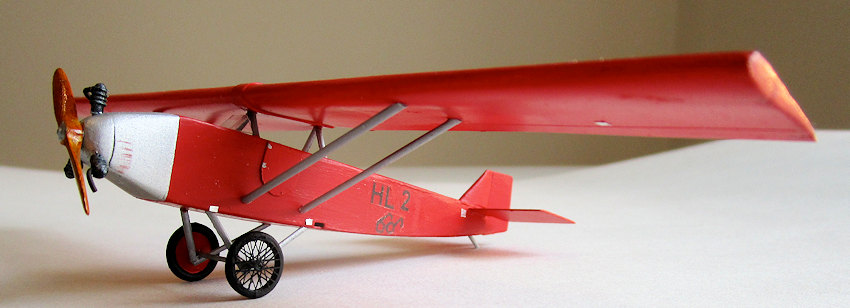
| KIT #: | |
| PRICE: | $ |
| DECALS: | hand made |
| REVIEWER: | Chris Peachment |
| NOTES: | Ten and 20 thou plastic card, rod, strut, and a pair of spectacles. |

| HISTORY |
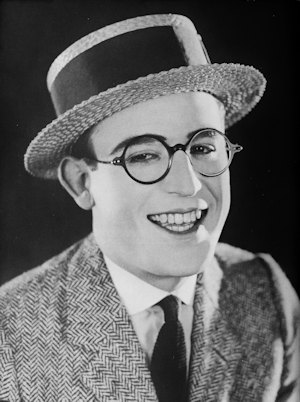 This is the only aircraft named after a famous
silent film comedian. I do not know of any aircraft called the Charlie Chaplin
2, nor one named the Buster Keaton 2, but the initials HL of this aircraft stand
for Harold Lloyd. I assume that “Haroldek” is the Polish equivalent of Harold,
and that the figure -2 is there because the man himself counts as HL-1.
This is the only aircraft named after a famous
silent film comedian. I do not know of any aircraft called the Charlie Chaplin
2, nor one named the Buster Keaton 2, but the initials HL of this aircraft stand
for Harold Lloyd. I assume that “Haroldek” is the Polish equivalent of Harold,
and that the figure -2 is there because the man himself counts as HL-1.
Most of Lloyd's films are now lost to history, and he is not now so popular as his two contemporaries, Chaplin and Keaton, but, at the time, he was more prolific than Chaplin, and his films made more money, some $15.7m compared to Chaplin's $10.5m.
He was best known for his bespectacled “Glasses” character, and one of the greatest film stills from the silent era show him hanging from the hands of a clock, high above a street. That aerial stunt might well be reason for this aircraft's name.
It was the first independent design of Josef Medwecki who worked for the Samolot company in Poznan. After his plans were green lighted by the aviation authority he began making it with some factory employees and friends in 1926. He worked under the guidance of Ryszard Bartel, who went on to design Polish military aircraft which bear his name. The initial wood-work was done in the attic of his house, and then the final assembly in the empty hall of a nearby railway station, provided free by the station manager who had an interest in aircraft.
The 3 cylinder 35 hp Anzani engine was borrowed from the factory. As you can see, the aircraft was bright red and it sported a pair of spectacles as its markings.
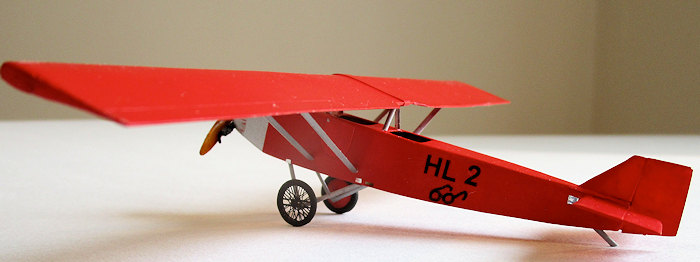 The initial goal was
the first National Light Aircraft Competition held in Warsaw in October 1927.
For some reason, one wheel was fabric covered, and the other was left with
uncovered spokes. Perhaps Medwecki wanted to add a distinctive feature to the
aircraft. Perhaps he ran out of linen. Or perhaps he just plain forgot.
The initial goal was
the first National Light Aircraft Competition held in Warsaw in October 1927.
For some reason, one wheel was fabric covered, and the other was left with
uncovered spokes. Perhaps Medwecki wanted to add a distinctive feature to the
aircraft. Perhaps he ran out of linen. Or perhaps he just plain forgot.
The aircraft was flown from Poznan the day before the competition, but had to make a forced landing because of a broken fuel tube. It was repaired, but then the aircraft was allowed to start only outside of competition. Calculations showed that it scored a few points more than the winner along the way, but its engine failed on the last leg of the competition. The engine was removed and the frame put on a truck, but fate did not smile on Harold Lloyd 2, and it was destroyed in a road accident.
Despite this long catalogue of mishaps, the German magazine German Flug-Sport was sufficiently impressed to put the HL-2 on its cover, with a special feature on it inside.
| CONSTRUCTION |
I came across this neat little sports plane while browsing a card modelling site, which is something I would recommend to all modellers even if they only stick to plastic. You will greatly increase your knowledge of aviation in general, and many of the sites offer free downloads of their ready-printed aircraft. Even if you do not want to make a model out of paper, they can be invaluable scale plans.
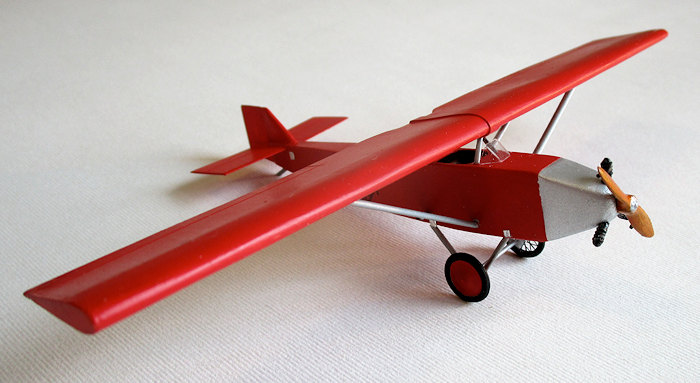 It is a simple, though elegant design, and so
construction couldn't have been easier. Four lengths of card, cut to shape, form
the fuselage. Remember to cut out the square-ish cockpits apertures. The
interior can be made up from scraps and off cuts. I had run out of old seats in
the Big Bag of Deceased Cockpits, and so I made them from paper, which is
probably much more to scale thickness. There are two stick and two panels inside
there too, though they are hidden under that wing.
It is a simple, though elegant design, and so
construction couldn't have been easier. Four lengths of card, cut to shape, form
the fuselage. Remember to cut out the square-ish cockpits apertures. The
interior can be made up from scraps and off cuts. I had run out of old seats in
the Big Bag of Deceased Cockpits, and so I made them from paper, which is
probably much more to scale thickness. There are two stick and two panels inside
there too, though they are hidden under that wing.
The only tricky bit is the nose which features a compound curve leading down to the nose cone, and it as here that the paper templates proved invaluable, since it is offered as one piece, complete with cut lines. I simply traced it onto pieces of thin plastic card. The nose cone was sanded down from a larger nose cone. The three cylinders were cut from a five cylinder radial, and the exhausts were added from bent bits of copper wire. They were promptly knocked off with handling and so reserved for later.
The wing is one piece of thin card, folded over a spar at 1/3 of the chord back from the leading edge. The original wing was made of wood, and so there is no need to score inside for ribs. There is a joining band at the mid-point, which is handy as that needs to be drilled to accept the twin cabane struts. That is the only weak point of the aircraft, as the struts come to a single point on which the wing is balanced, and so some strengthening rod inside is a good idea.
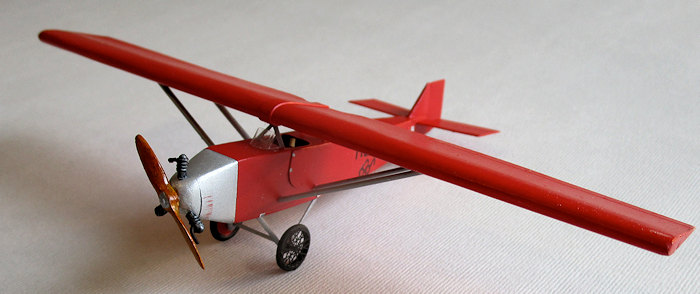 Once the wing is more or less balanced, then add
the four bracing struts and align carefully while allowing to dry. As usual this
was done with my very sophisticated jig, lashed together from a few old
paperbacks, dried up paint pots, a couple of kebab skewers, and a metal
thingummy whose name I don't know.
Once the wing is more or less balanced, then add
the four bracing struts and align carefully while allowing to dry. As usual this
was done with my very sophisticated jig, lashed together from a few old
paperbacks, dried up paint pots, a couple of kebab skewers, and a metal
thingummy whose name I don't know.
The undercarriage struts couldn't be simpler, nor could the tail planes which are rectangles of card, with the surface joins marked with a scalpel.
Blast it all red, except for the nose which is aluminium. I used Carmine Red, number 70.908 from the Vallejo range, which is a pleasing shade, and for all anyone knows might even be close to the original. The HL 2 on the side represents the limits of my decal making skills, and the whimsical pair of spectacles were drawn free hand with a very narrow felt tip pen. It took me a mere 30 attempts on an old sheet of decal paper, to get two that I could use.
The cockpit has a door on the port side, which was
now added, much too late in the proceedings, thus bringing on much eye-narrowing
and lip-biting. A nice touch are the inspections panels, and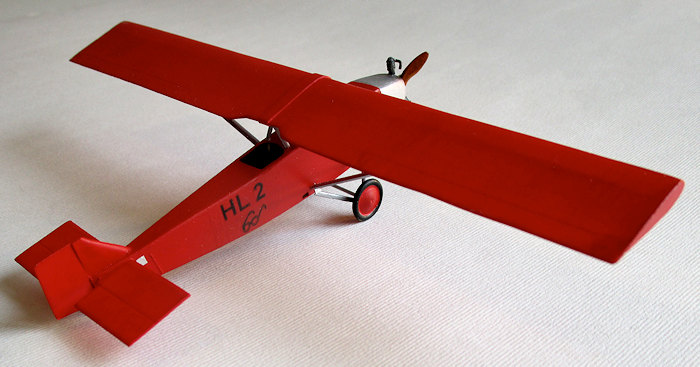 also the
undercarriage strut mounting points, which were all done in tiny squares of
chrome tape. They add a little something to what is otherwise a plain colour
scheme. The windscreen was cut from celluloid, and here again, the paper
template from the plans proved invaluable.
also the
undercarriage strut mounting points, which were all done in tiny squares of
chrome tape. They add a little something to what is otherwise a plain colour
scheme. The windscreen was cut from celluloid, and here again, the paper
template from the plans proved invaluable.
One wheel came from the Big Bag of Dead Wheels, the other from Eduard's excellent etched wire wheels. Alas, I am now left with one left-over etched wheel from what used to be a pair. I am going to have to find a mono-wheel racer from the 30s to build, just so that I don't get out of step.
The exhausts were re-glued in place, painted with a little rust. Finally a propeller from the Bag of Dead Props, was painted wood and mounted at ten to four.
| CONCLUSIONS |
It didn't set the world on fire, but the HL-2 was an honourable failure, especially when you consider that it was Medwecki's first attempt at a home-built aircraft. When WWII broke out he was evacuated to France, where he worked for SNCASE, and after that he went to Great Britain and Canada, working for, among others, De Havilland and the tractor manufacturer Massey-Fergusson. Make this aircraft and you will be honouring him, and also a great comedian.
| REFERENCES |
http://wp.scn.ru/en/ww15/o/2034/29_o/0
http://www.samolotypolskie.pl/samoloty/1823/126/HL-2-Haroldek
https://pl.wikipedia.org/wiki/HL-2
http://www.model-making.eu/products/HL-2-Haroldek.html
Chris Peachment
April 2016 Copyright ModelingMadness.com If you would like your product reviewed fairly and fairly quickly, please
contact the editor
or see other details in the
Note to
Contributors.